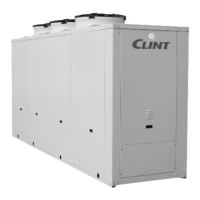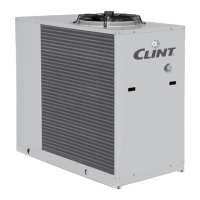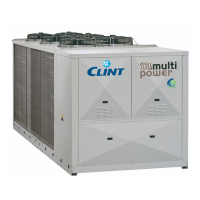18
5.2.2 Evaporator
It is vitally important that the water enters
the unit from the connection point marked
with the “WATER INLET” plate.
Threaded or flanged male unions, depending on the models,
are used to make water connections (please refer to the scale
drawings which also show the position of the unions).
It is vitally important to connect the water cir-
cuit so that the flow of water to the exchanger
is always constant under all operating condi-
tions. A variable flow of water is only accepted
for units with the desuperheaters.
As the demand for cooling by utilities does not gener-
ally coincide with what is delivered by the compressors,
they often work intermittently. In units with a low water
content, where the effect of thermal inertia is not felt so
much, the system should be checked to make sure it
satisfies the following relation:
V > P/115n
where:
V = volume of water (litres)
P = power capacity of the unit (Watts)
n = number of capacity steps.
If the above volumes are not obtained, a storage tank
should be installed so as to satisfy the above relation
when added to the capacity of the system.
This tank requires no special features; it just needs to
be isolated, just like the chilled water pipes, so as not
to affect the performance of the system and to prevent
the formation of condensation.
A safety valve should be installed on the water
circuit (if not already fitted). In case of serious
system faults (e.g. fire) this will allow the sys-
tem to be drained in order to prevent the risk of
explosions. Always connect the drain to a pipe
with a diameter not less than that of the valve
opening and install the outlet in an area where
the jet cannot cause harm to people.
Attention!
While connecting the water circuit, never
work with naked flames near to or inside
the unit.
5.3 ELECTRICAL CONNECTIONS
5.3.1 General
These operations may only be carried out
by specialised staff.
Before carrying out any operations on elec-
trical components, make sure the unit is dis-
connected from the mains power supply.
5.2.2 Parownik
Istotne jest aby woda była doprowadzana
do urządzenia przez przyłącze oznaczone
tabliczką „WATER INLET” (wlot wody).
Złącza męskie gwintowane lub kołnierzowe, w zależ-
nościod modelu, stosowane są jako przyłącza wodne
(patrz schematy wskazujące rozmieszczenie złączy).
Ponieważ zasadniczo zapotrzebowanie na chłód nie
pokrywa się z mocą generowaną przez sprężarki, pra-
cują one z przerwami. W jednostkach o małej pojem-
ności wodnej, dla których efekt inercji cieplnej nie jest
zbytnio odczuwalny, należy sprawdzić system pod
względem spełniania następującej zależności:
V > P/115n
gdzie:
V = pojemność wody (litry)
P = moc urządzenia (waty)
n = ilość stopni wydajności.
Ważne jest aby podłączenie obiegu wodnego
umożliwiało regularny przepływ wody do wy-
miennika niezależnie od warunków pracy.
Niestały przepływ wody dopuszczalny jest
tylko dla jednostek wyposażonych w wymien-
niki dochładzające.
Jeżeli powyższe wartości nie zostaną osiągnięte, należy
zamontować zbiornik w celu zagwarantowania powyższej
relacji w przypadku zwiększania wydajności systemu.
Zbiornik nie wymaga dodatkowych elementów; należy
go zaizolować w ten sam sposób jak przewody wody
chłodzonej, aby nie wpływało to na zmniejszenie wydaj-
ności systemu i ograniczyło tworzenie się kondensacji.
Zawór bezpieczeństwa należy zamontować
na obiegu wodnym. W przypadku poważnej
awarii systemu (np. pożar) zawór ten umo-
żliwi odprowadzenie czynnika z systemu aby
uniknąć eksplozji. Zawsze podłączaj odpływ
do rurki o średnicy nie mniejszej niż średnica
przyłącza zaworu oraz montuj wylot w miejscu,
gdzie strumień nie spowoduje obrażeń.
Uwaga!
Podczas podłączania obiegu wodnego nigdy
nie używaj otwartego ognia w pobliżu lub
wewnątrz urządzenia.
5.3 INSTALACJA ELEKTRYCZNA
5.3.1 Ogólne wytyczne
Czynności te mogą być wykonywane tylko
przez wykwalifikowany personel.
Przed przystąpieniem do czynności związanych
z podzespołami elektrycznymi upewnij się, że
urządzenie zostało odłączone od źródła zasilania.

